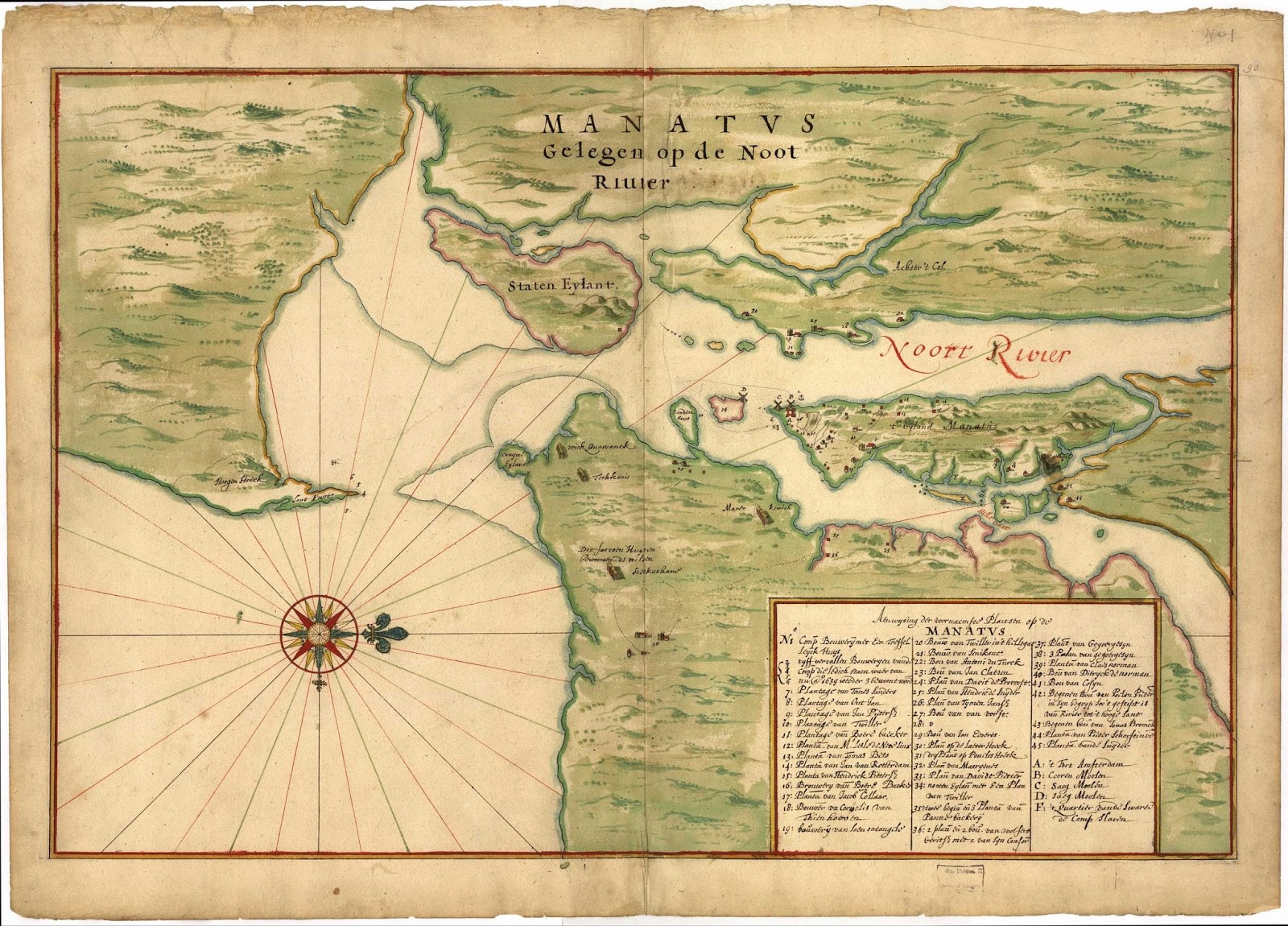Staten Island (Staaten Eylandt) was particularly important to the Dutch West India company because of its strategic location, and potential for farming so close to Manhattan Island. There was clearly a lot of controversy of ownership of this land, and here are just a few examples. Use the Timeline button to see more.
1630 DWIC issues a patent to Michael Pauw for Staten Island
1641 - The Pig War - The Raritans were accused of stealing pigs, and several of them were killed and their crops destroyed. In return, they burned the entire Dutch settlement on Staten Island to the ground.
Read more about Cornelis Melyn.
1643-45 - The Whiskey War / Kieft's War - An ongoing escalation of hostilities between the Raritans, Wappingers, Hackensacks and other tribes that occupied Staten Island.
1655 - The Peach War - A young Indian woman Tachiniki from the Wappingers tribe was killed by Hendrick van Dyck for stealing a peach from his property. The people of New Amsterdam believed that in retaliation the Hackensacks and Susquehannocks attacked Dutch settlements in the Hudson Valley, New Jersey, and Staten Island. Early in the morning of September 15, 1655, more than 500 Native Americans in approximately 68 canoes (mishoons) landed near the southern edges of Manhattan. The settlement contained approxmately 300 houses.
The invasion force included members of a variety of tribes like the Susquehannocks and they began breaking down doors, ransacking houses, threatened or beat some of the settlers, but no deaths or serious injuries occurred in the invasion. The sachems met with the governing council at Fort Amsterdam and agreed to leave at sunset. Meanwhile, the councillors called the citizens to arms and a guard was mounted. As the Native Americans began to depart, Hendrick van Dyck was shot and wounded by an arrow. Cornelis van Tienhoven ordered the guard to open fire, and what would have been a peaceful departure became a fight in which 3 Native Americans and 3 settlers were killed.
The Native Americans then divided into 2 groups, one crossed the Hudson River and attacked Paviona, and the other attacked Staten Island.
Stuyvesant later reported that in the attacks “40 Christians” were killed and 100, mostly women and children, taken captive. He further reported that 28 farms had been destroyed, 12,000 skipples (9,000 bushels) of grain burned, and 500 head of cattle taken or killed.
On Staten Island, 23 Dutch Settlers were killed and 67 were captured by the Hackensack tribe. Captain Adriaen Crijnin Post, who led the settlement of the Colony for Baron Hendrick van der Capellan, had learned the language of the Natives. Chief Penneckeck trusted him and permitted him to leave captivity to negotiate with Stuyvesant for the release of the settlers on behalf of the Natives. The captives were safely returned, including his own wife and children, for the price of ammunitions, wampum and blankets.
The Baron ordered the 67 settlers to return and build a fort. They found their homes burned to the ground, crops destroyed or damaged, and their livestock and horses set free to roam or killed. Many of the inhabitants soon moved to the Long Island Colony. Post remained with a few settlers to fulfill the Baron's wishes, but his health declined temporarily and he was not able to complete his goal. He eventually moved his family to what became Bergen County, New Jersey after the British gained control.
Some scholars believe that the Peach War began because of the attach on New Sweden by Petrus Stuyvesant and his forces.
1659, 2 years later, Cornelis Melyn signed a Deed of Surrender https://encyclopedia.nahc-mapping.org/document/deeds-surrender-cornelis-melyn-his-rights-patroon-staten-island-amsterdam-chamber-w-i
1660 - A peace treaty is signed with the Raritan, Hackensack, and others.
1661 - Several settlers petition for land on Staten Island including Pierre Billou https://encyclopedia.nahc-mapping.org/document/petition-several-recently-arrived-immigrants-land-staten-island
At the time the DWIC became interested in Staten Island, the Native Americans who fished, hunted, and raised crops there included the Raritan tribe of the Algonkians and the Hackensack. There remains evidence of their residence there in the form of of burial grounds, shell middens, arrowheads etc. today. Because the Algonkians had a nomadic tradition, slash and burn agriculture, fishing and hunting all took place on Staten Island in seasons when hunting and fishing was particularly good. It is likely that by the Little Ice Age, the Native Americans may not have wished to overwinter on the small island every year. A number of tribes utilized the island including Hackensack, Raritan, and many others. Over the course of many years, violence between the Dutch settlers and DWIC soldiers vs. Native Americans on Staten Island led to a chaotic series of documents relating to land rights there.

Manatus, by Johannes Vingboons 1639

